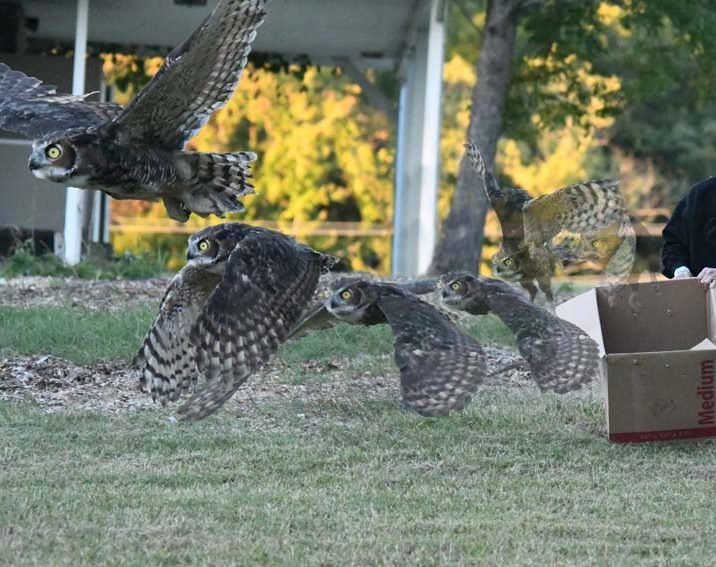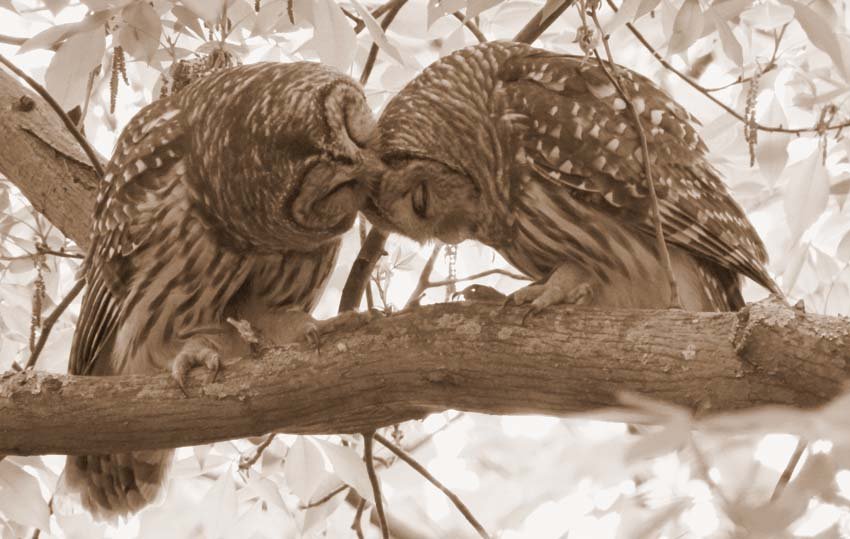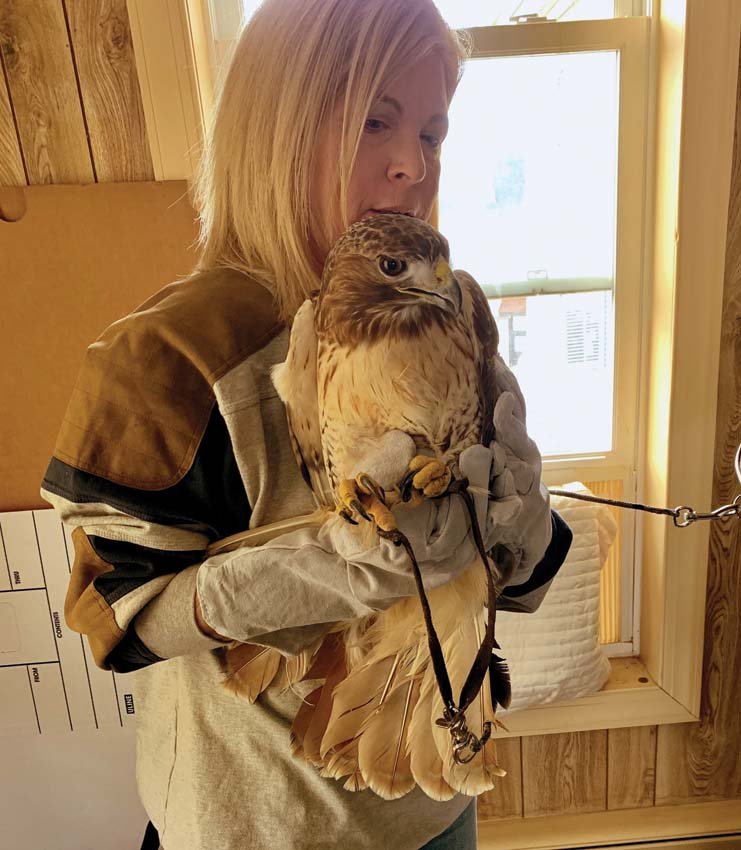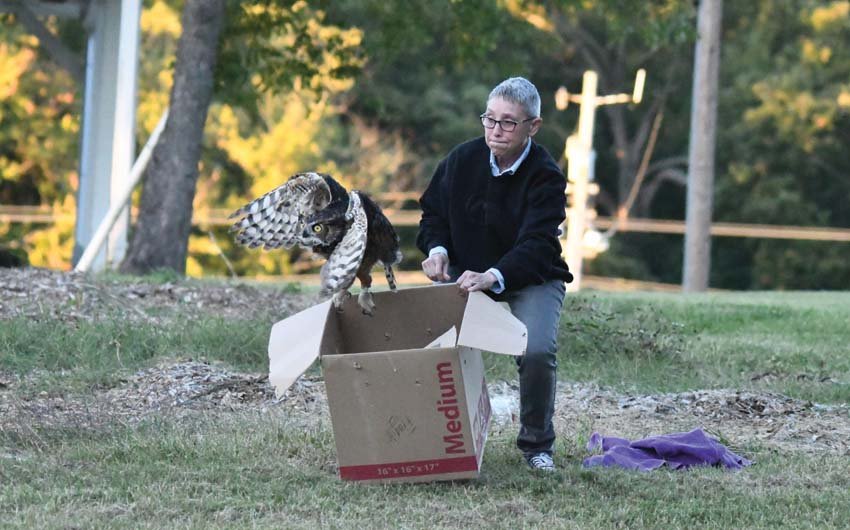+ By Andrea Stuart
Sitting on a wrought iron perch that reaches up from the ground, a juvenile barred owl stares at Donna L. Cole, an award-winning investigative and multimedia journalist. The bird’s deliberate black eyes contrast its softly mottled gray and brown feathers, still downy with youth. On any given day, Cole can peer from her bedroom window to see owls, such as this one, who have found sanctuary in her yard.
Cole’s bed is imprinted by her body; its linens are a cocoon that holds her when the pain becomes nonnegotiable. Her longhaired Weimaraner, Ludwig, lies by her side. Some people might find a room where so many hours are spent confining. For Cole, this space has given birth to a life and world outside of her discomfort.
After Cole’s bilateral mastectomy, in 2012, her life was obscured by a color conversion lens that washes a previously vibrant landscape with dampened hues of blue. Nerve damage and debilitating pain—as Cole has come to know recovery—are relentless contenders that threaten to down the US Navy veteran after she won the war over cancer.

That year, on June 13, while standing on a grassy knoll along a private recreational area of the Severn River, Cole and her then 10-year-old daughter, Rylan, felt the weight of a winged shadow from above. In the sky, a brown and white sculpture soared: a juvenile bald eagle. Nearby, an adult eagle sat on a piling and another juvenile rested on the dock. “In that moment, I was changed,” she says. “It was the first time I had ever seen bald eagles in the wild. These birds were on the brink of extinction because of DDT. But thanks to Rachel Carson, they’ve bounced back. Now, my daughter views them as ubiquitous as squirrels.”
The imprint left on Cole was still fresh when, later that month as she lay in bed, “blobs” flitted outside her bedroom window. Stymied by what she assumed was an opioid-induced apparition, Cole then heard a high-pitched screech. Summoning strength, she made her way to the backyard, where she saw broad wings soaring through the yard. They belonged to two juvenile barred owls who had left the nest, their adult parents nearby. “There is no cuter thing than watching those baby barred owls grow from the comfort of my own home,” she says. “One year, one landed on my bird feeder five feet from my window.”
Before long, Cole found herself at Conowingo Dam, one of the largest gathering spots of bald eagles outside of Alaska during the winter months. “There’s ample opportunity to photograph birds in flight,” she says. “The comeback of the bald eagle is among the greatest conservation success stories of my lifetime and the only one I’ve personally witnessed.”
Already an experienced photographer, Cole became inspired to expand her repertoire to include nature, especially birds. Sometimes, with her Nikon D500 in tow or with a simple point-and-shoot camera—one of her favorites due to its light weight and easy maneuverability—she captures images of bald eagles, great blue herons, ospreys, songbirds, and, when they visit, snowy owls.
As a Navy veteran, Cole has a deep love for the United States of America and for the bald eagle. In 2019, when Maryland State Parks Ranger Jessica Conley organized and opened a rapture rescue and triage class to the public at Tuckahoe State Park—a program created by Ranger Sarah Milbourne at Rocky Gap State Park—Cole was among the first in line for attendance. Since her formal training, she has become a volunteer bird rescuer at Owl Moon Raptor Center and has helped rescue over 100 birds along the Mid-Atlantic.

She might not have taken that class if not for working at WNAV. In 2018, two years after 13 bald eagles were found dead, the media had stopped reporting on those federally protected birds and the US Fish and Wildlife Service had closed the case, citing lack of evidence. “I was infuriated. Where were all the reporters?” she says with fire on her tongue. “Then, I realized I was it! I’m a journalist, and I’m an animal lover.” She needed to find out what was killing them. The culprit was carbofuran, a federally banned pesticide. “In spring 2018, I broke the story on WNAV. The New York Times and the Washington Post, among other media outlets, shared that reporting.” Cole’s work covering the poisoning has led to numerous journalism awards and changes in pesticide licensing regulations in Maryland. She continues to share bird of prey reports on her website, Annapolis Creative.
Birds of prey are wild and unpredictable, and thus rescue work is equally gritty. Cole finds it gratifying, terrifying, and humbling. No two rescues are alike, and each one requires patience and skill. “These birds are fierce and beautiful. In rescue scenarios, they are helpless,” she explains. “It’s imperative that we protect ourselves as much as we protect the birds.”
Birds of prey, in particular, end up in distress for myriad reasons. Among the most common are rodenticide or lead poisonings, fishing lines, gunshot wounds, vehicle strikes, window strikes, and illnesses.
There are numerous moving parts in a rescue effort. After a call comes in about a bird in distress, a rescuer is deployed. The bird is placed in a cardboard box with breathing holes and handed over to a transporter, who takes the animal to a licensed bird of prey rehabilitator. The rehabilitation facility medically treats the sick or injured bird. But some rescues require deviation from that process.

In September 2021, Cole received a call from an off-duty ranger in Annapolis. A family reported an injured eagle at their home. Sunset had cast the sky in purples and grays, ebbing into darkness and greater uncertainty. This forced Cole and the homeowner to race against dusk and work diligently to coax the eagle from tall reeds. After finally succeeding, she brought it back to her house to meet another rescuer, who delivered another bald eagle. She transported both eagles to Owl Moon Raptor Center in Boyds, Maryland. “There, Suzanne Shoemaker, the director, was without volunteers. So, I stayed until 11 p.m. holding birds for her so she could treat them,” she says.
The rescue world is often in need. In 2020, as the COVID-19 pandemic escalated, bird rescues were short on transporters. Rescuers, who had also been transporting, couldn’t keep up with the turnover. “I put out a call on Facebook for transporters,” says Cole. “That transpired into a group of over 80 transporters in Maryland, Delaware, Washington DC, and Pennsylvania.”
She credits her fellow rescuers and the licensed wildlife rehabilitators they volunteer for who have deep knowledge of and great success with rescue and rehabilitation efforts. “I don’t know why, but the rescue world is largely made up of badass women,” says Cole with a soaring laugh. “I would not want to be surrounded by anyone else. They have everyone’s and every bird’s back. They go head-to-head with talons, time and time again.”
Despite the atrocities that require Cole to continue her reporting and rescue work, she keeps a surprisingly positive attitude. “Rescue work helps me as much as it helps the birds. They rescued me first,” says Cole of why she is compelled to keep going, even when her body resists. “Photography, on the other hand, takes me somewhere else. When I look through the lens, I am in a different space. I’m not in my painful body.”
At the end of the day, when Cole is resting her weary body, she sees from her window a pair of barred owls roosting in a nearby tree. One reaches over and begins preening the other’s head. The recipient closes its eyes, bows its head, and leans into the show of affection. These precious moments keep Cole grounded to what matters most in life: the natural world she works hard to protect. █
To learn more about
Donna L. Cole’s work,
visit www.annapoliscreative.com.





























